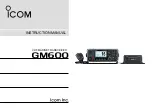
42 August 2023
QST
www.arrl.org
is the “programmable key.” Out of the box, the key is
pushed to enter the 1 MHz step selection mode for fast
tuning. Hold the key down to enter the tuning step item
in the set mode
,
and set the tuning step from 5 kHz up
through 200 kHz.
On the top panel, the large, tall knob is the control dial
.
In the VFO mode, it is rotated to select the operating
frequency (based on the tuning step selected, as de-
scribed above). In memory mode, it is rotated to select
the memory channel. In the set mode, it’s rotated to
select an option. In the character entry mode, it’s ro-
tated to select an alphanumeric character
when naming a repeater. The smaller knob just
to the right of the control dial is the volume/
power knob
;
rotate it to the right to turn on the
radio, and continue to rotate it for increased
audio volume output.
On the right
side panel is an external micro-
phone/speaker jack, which has a removable
cover protection; this needs to be kept on or
with the optional external microphone attached
to meet the IP67 requirements for dust-tight
and waterproof protection.
Function Display
On the front panel, the function/frequency
screen is basic but complete. It shows the
operating frequency/memory with the alpha-
numeric programmed name, and features like
the battery capacity, duplex, tone, VOX, auto-
matic power off, key lock, memory channels,
and more.
The signal RF bar meter displays the
relative strength of the incoming
signal, and the relative RF output
of the radio on transmit. An
operating mode icon is dis-
played for FM, and
FMN
for
Bottom Line
The Icom IC-T10
is a small dual-
band handheld
transceiver that is
solidly built, well
designed, and
easy to use right
out of the box.
FM narrowband operation. Power icons are displayed
—
L
for low power,
M
for medium power, and no icon is
displayed when the radio is in high
-
power mode.
The battery is charged by the included BC-213 drop-in
charger cradle
,
and a spare battery pack can be
charged in the cradle without the radio.
There are four frequency selection modes: VFO, mem-
ory, call channel, and
w
eather
c
hannel. In VFO mode,
the operating frequency can be selected by rotating
the dial knob. In memory mode, a memory channel
that has been programmed by the user can be se-
lected. In call
c
hannel mode, the operator can recall
the two most often used frequencies programmed by
the user. Note that the
BAND
button is pushed to toggle
between the two call channels. The w
e
ather
c
hannel
mode is selected to monitor channels of NOAA
weather broadcasts.
To select the operating band, fi rst select the VFO
mode, then push the
BAND
button repeatedly to select
the VHF band, the UHF band, and the FM broadcast
radio band.
Set the operating frequency using the keypad numbers
or by turning the top panel
DIAL
button while in VFO
mode. RF power output can be set to approximately
5 W (high), 2.5 W (mid), or 0.5 W (low) by repeatedly
pushing the
H/M/L
button on the front panel (it is indi-
cated on the bottom of the display screen). To lock
down the operating frequency, hold down the
SET/KEY
icon button.
The home channel — selection of the most often used
frequency for VHF and UHF — is accomplished by
pushing the simple, tiny
HOME
button on the top panel
between the volume knob and the dial knob, and cy-
cling through them by repeatedly pushing the
BAND
button. The frequencies are stored by selecting the
frequency and then holding down the
HOME
button
until a beep sounds.
To set function values, push the
SET
button. Once the
SET function is displayed, push the
SET
button repeat-
edly to toggle between functions. For example, to set a
repeater tone, push the
SET
button, and then push it
again repeatedly until the
TONE
function appears.
Rotate the dial knob one click to turn it on. Then push
the
SET
button one more time to select the repeater
tone frequency. Rotate the dial knob to select and set
the desired tone frequency. Other frequently used
standard SET items include duplex reverse, tuning
step, priority scan, tone scan, etc. Several initial SET
mode items program the radio for basic “set and for-
get” settings.
Reprinted with permission; copyright ARRL.























